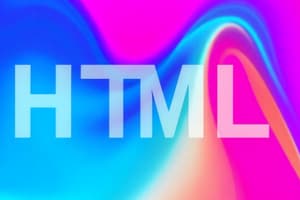Podcast
Questions and Answers
What is the primary purpose of HTML?
What is the primary purpose of HTML?
- To create graphics for websites.
- To style web pages using CSS.
- To run server-side scripts.
- To structure content on the web. (correct)
Which tag represents the highest level heading in HTML?
Which tag represents the highest level heading in HTML?
- <h3>
- <h6>
- <h1> (correct)
- <h2>
Which element is used to create hyperlinks in HTML?
Which element is used to create hyperlinks in HTML?
- <link>
- <anchor>
- <a> (correct)
- <url>
What does the <form> element do in HTML?
What does the <form> element do in HTML?
Which of the following is a new feature introduced in HTML5?
Which of the following is a new feature introduced in HTML5?
What is the purpose of using semantic HTML?
What is the purpose of using semantic HTML?
What attribute would you use to trigger a JavaScript event in an HTML element?
What attribute would you use to trigger a JavaScript event in an HTML element?
Which HTML element is used for embedding audio content?
Which HTML element is used for embedding audio content?
Flashcards are hidden until you start studying
Study Notes
HTML Overview
- Definition: HTML (HyperText Markup Language) is the standard markup language for creating web pages.
- Purpose: Structure content on the web, allowing browsers to render text, images, and multimedia.
Basic Structure
- HTML Document:
<!DOCTYPE html>: Declaration to define document type.<html>: Root element of an HTML page.<head>: Contains meta-information, title, and links to styles/scripts.<title>: Sets the title of the webpage, displayed in the browser tab.<body>: Contains the content of the webpage (text, images, etc.).
Common HTML Elements
- Headings:
<h1>to<h6>: Define headings,<h1>is the highest level.
- Paragraphs:
<p>: Defines a paragraph of text.
- Links:
<a href="URL">: Creates hyperlinks to other pages or resources.
- Images:
<img src="URL" alt="description">: Embeds images in the page.
- Lists:
<ul>: Unordered list (bulleted).<ol>: Ordered list (numbered).<li>: List item.
- Divisions and Spans:
<div>: Block-level container for grouping elements.<span>: Inline container for styling a portion of text.
Attributes
- Global Attributes: Common to all HTML elements (e.g.,
class,id,style,title). - Event Attributes: Trigger JavaScript events (e.g.,
onclick,onchange).
Forms and Input
- Forms:
<form>: Container for user input elements.<input>: Various input types (text, password, checkbox, radio, etc.).<textarea>: Multi-line text input.<button>: Clickable button for form submission.
Semantic HTML
- Definition: Use of HTML markup that conveys meaning about the content.
- Elements:
<header>: Introduction or navigational section.<footer>: Footer content of the document.<article>: Self-contained composition.<section>: Thematic grouping of content.<nav>: Navigation links.
HTML5 Features
- New Input Types: Email, date, range, etc.
- Multimedia Support:
<audio>: Embeds audio content.<video>: Embeds video content.
- Canvas Element:
<canvas>: For drawing graphics on the fly. - Local Storage: Browser storage capability to store data.
Best Practices
- Use semantic HTML for better accessibility and SEO.
- Ensure proper closing of tags to maintain structure.
- Validate HTML code for standards compliance and cross-browser compatibility.
HTML Overview
- HTML (HyperText Markup Language) is the standard for creating web pages.
- Its primary purpose is to structure web content, enabling browsers to display text, images, and multimedia effectively.
Basic Structure
- An HTML document begins with a declaration to define the document type.
- The
<html>tag represents the root element of an HTML page. - The
<head>section contains meta-information, the webpage title, and links to styles and scripts. - The
<title>tag specifies the title of the webpage, which appears in the browser tab. - The
<body>tag holds the visible content of the webpage, including text and images.
Common HTML Elements
- Headings are defined from
<h1>to<h6>, with<h1>being the most important. - The
<p>tag is used to define a paragraph of text. - Hyperlinks are created with the
<a>tag for linking to other pages or resources. - The
<img>tag is utilized to embed images in the webpage. - Lists can be unordered (
<ul>) for bulleted items, ordered (<ol>) for numbered items, and list items are defined with<li>. <div>serves as a block-level container for grouping elements, while<span>is an inline container for styling specific text portions.
Attributes
- Global attributes like
class,id,style, andtitleapply to all HTML elements. - Event attributes such as
onclickandonchangeare used to trigger JavaScript events.
Forms and Input
<form>is the container for user input elements.- Various
<input>types include text, password, checkbox, and radio, allowing diverse user interactions. - The
<textarea>tag enables multi-line text input. - The
<button>tag creates a clickable button to submit forms.
Semantic HTML
- Semantic HTML utilizes markup that conveys meaning about the content, enhancing clarity and accessibility.
- Semantic elements include
<header>for introductory/navigation sections,<footer>for document footer content,<article>for self-contained compositions,<section>for thematic groups, and<nav>for navigation links.
HTML5 Features
- HTML5 introduces new input types like email, date, and range for better user experience.
<audio>and<video>tags provide multimedia support by embedding audio and video content directly into web pages.- The
<canvas>element allows for drawing graphics dynamically. - Local Storage enables browsers to store data for enhanced functionality and user experience.
Best Practices
- Emphasize the use of semantic HTML to improve accessibility and search engine optimization (SEO).
- Ensure all tags are properly closed to maintain document structure.
- Validate HTML code to comply with standards and ensure compatibility across different browsers.
Studying That Suits You
Use AI to generate personalized quizzes and flashcards to suit your learning preferences.




